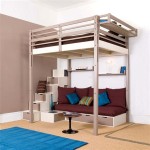Transition From Crib to Full Size Bed: A Comprehensive Guide
The transition from a crib to a full-size bed marks a significant milestone in a child's development. It represents a move towards greater independence and a more mature sleeping environment. However, this transition can be challenging for both the child and the parents. Careful planning, thoughtful preparation, and a gradual approach are crucial for ensuring a smooth and successful changeover. This article provides a comprehensive guide to navigating this transition, covering key considerations and practical strategies.
The decision to transition a child from crib to bed is not solely dictated by age. While many children make this move between the ages of 2 and 3.5 years, developmental readiness is the primary factor. This readiness encompasses both physical and emotional aspects. Physically, the child should be able to climb out of the crib safely and understand the concept of staying in bed. Emotionally, the child should exhibit a degree of independence and be able to understand and follow simple instructions.
Forcing the transition before the child is ready can lead to resistance, anxiety, and sleep disruptions. Conversely, delaying the transition for too long might hinder the child's development of independence. Parents must carefully observe their child's behavior and assess their readiness before embarking on this process.
Key Point 1: Assessing Readiness and Timing
Determining the optimal time for the transition hinges on a multifaceted assessment. Several factors contribute to a child's readiness, and understanding these factors can help parents make an informed decision. These include physical development, emotional maturity, and external circumstances influencing the child's sense of security.
Physical readiness is demonstrated by the child's ability to climb out of the crib. This ability, while seemingly convenient for the child, poses a safety risk if the child attempts to do so unsupervised. If a child is consistently climbing out of the crib, it might be a sign that they have outgrown it and a transition is necessary to prevent falls and injuries. It is important to note that simply lowering the crib mattress might not always be a sufficient solution, as determined and agile children can often overcome this obstacle.
Emotional maturity is equally important. The child should be able to understand simple instructions, such as staying in bed and not getting up without permission. They should also be able to communicate their needs and concerns effectively. A child who is experiencing significant stress or anxiety might not be emotionally ready for this change. Introducing the full-size bed during a period of upheaval, such as the arrival of a new sibling or a move to a new home, can exacerbate the child's anxiety and make the transition more difficult.
External circumstances can also influence the timing of the transition. If a new baby is on the way and the crib is needed for the infant, it might seem logical to move the older child into a full-size bed. However, this can lead to feelings of resentment and displacement in the older child. If possible, it is best to make the transition several months before the baby arrives, allowing the older child time to adjust to their new bed and avoid associating it with the new sibling.
A gradual approach is often the most effective. Start by introducing the concept of the new bed to the child and allowing them to spend time in the room. Let them help choose bedding and decorate the space to make it feel like their own. Read stories to the child in the new bed during the day, and encourage them to take naps there. Once the child seems comfortable with the idea of sleeping in the new bed, try transitioning them for one night at a time. If they become distressed, reassure them and allow them to return to the crib. Over time, the child will gradually become more comfortable and confident in their new bed.
Key Point 2: Preparing the Room and Bed
Creating a safe and comfortable sleep environment is paramount for a successful transition. The room and bed should be designed to promote relaxation and a sense of security. This involves addressing safety concerns, ensuring comfort, and fostering a positive association with the new sleeping space.
Safety is the primary concern. Ensure the room is free of hazards, such as sharp edges, loose cords, and heavy objects that could fall. Install safety gates on the stairs if necessary. Childproof the outlets and secure furniture to the walls to prevent tipping. Consider using bed rails to prevent the child from falling out of bed, especially during the initial stages of the transition. These rails provide a physical barrier and can offer a sense of security to the child.
Comfort is also essential. Choose a comfortable mattress and bedding that are appropriate for the child's age and size. Consider using familiar bedding, such as blankets or pillows from the crib, to help the child feel more secure. Avoid using overly stimulating bedding with bright colors or busy patterns, as this can interfere with sleep. A calming and neutral color scheme is often the most conducive to relaxation.
Make the room feel inviting and personalized. Allow the child to participate in decorating the space, choosing posters, artwork, or other decorations that reflect their interests. Create a cozy reading nook with comfortable cushions and plenty of books. A nightlight can also provide a sense of security and help the child navigate the room if they wake up during the night. Consistent room temperature and minimizing excessive noise are also crucial for comfortable sleep.
Associate the new bed with positive experiences. Read stories to the child in the bed, play quiet games, or simply spend time talking and cuddling. Avoid using the bed as a place for punishment or discipline. The goal is to create a positive association with the bed so that the child feels happy and secure in their new sleeping space. Consistency in the bedtime routine and positive reinforcement are critical for fostering a sense of security and acceptance.
Key Point 3: Establishing a Consistent Bedtime Routine
A consistent bedtime routine is crucial for promoting healthy sleep habits and easing the transition to a full-size bed. Children thrive on structure and predictability, and a consistent routine can help them feel secure and relaxed, making it easier to fall asleep and stay asleep throughout the night.
The routine should be calming and predictable, and it should be followed every night, even on weekends and holidays. This helps to regulate the child's internal clock and signals to their body that it is time to sleep. The routine should begin at the same time each night and should include a series of relaxing activities, such as a warm bath, reading a story, or listening to calming music.
Avoid screen time at least one hour before bed. The blue light emitted from electronic devices can interfere with melatonin production, making it harder to fall asleep. Instead, encourage quiet activities such as reading or playing with puzzles. A light snack, such as a glass of milk or a small piece of fruit, can also help to promote sleep, but avoid sugary or caffeinated foods or drinks.
The bedtime routine should be tailored to the child's individual needs and preferences. Some children might benefit from a massage or a back rub, while others might prefer to spend a few minutes talking about their day. The key is to find activities that are calming and enjoyable for the child and that help them to wind down before bed.
Once the child is in bed, avoid engaging in lengthy conversations or playing games. This can be stimulating and can make it harder for the child to fall asleep. Instead, offer a brief goodnight kiss and reassure the child that you will be there if they need anything. It is important to establish clear boundaries and to be consistent with enforcing them. If the child gets out of bed, calmly and firmly return them to bed and remind them that it is time to sleep. With patience and consistency, the child will eventually learn to stay in bed and fall asleep on their own.
Persistence and consistency are key to success. It may take time for the child to adjust to their new bed, and there may be setbacks along the way. Don't get discouraged if the child has difficulty sleeping in the new bed at first. Be patient, supportive, and consistent with the bedtime routine. Over time, the child will gradually become more comfortable and confident in their new sleeping space.
Addressing potential issues proactively can prevent disruption. Anticipating common challenges, such as night wakings and separation anxiety, allows for the development of strategies to cope effectively. A night light, comfort object, or white noise machine often provide support. Periodic check-ins without prolonged engagement can reassure the child without fostering dependence. Responding to specific needs with empathy and understanding while maintaining consistent boundaries provides reassurance.

Everything You Need To Know About Crib Conversion A Children S Bed With Very Little Time Energy Simply September

Diy Crib To Bed Conversion

Everything You Need To Know About Crib Conversion A Children S Bed With Very Little Time Energy Simply September

Full Size Conversion Kit Bed Rails For Greyleigh Baby Cribs

Everything You Need To Know About Crib Conversion A Children S Bed With Very Little Time Energy Simply September

Sstuff Full Size Conversion Kit Bed Rails

Davinci Baby Twin Full Size Bed Conversion Kit M4799

How To Convert A Crib Into Full Size Bed

Bassett Baby Full Size Conversion Kit Bed Rails On

Babyletto Swell 4 In 1 Convertible Crib With Toddler Conversion Kit Light Sage








